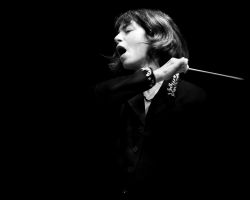|
Symphony
SRS SEASON ENDS WITH RESOUNDING TA-TA-TA-BANG
by Terry McNeill
Sunday, June 1, 2025
Symphony
YOUTHFUL VIRTUOSITY ON DISPLAY AT USO'S MAY CONCERTS
by Peter Lert
Saturday, May 17, 2025
Symphony
MYSTICAL PLANETS AND LIVELY GERSHWIN ORTIZ AT FINAL SRS CONCERT
by Peter Lert
Sunday, May 4, 2025
Symphony
VSO'S CONCERT MUSIC OF TIME, MUSIC OF PLACE
by Peter Lert
Sunday, April 27, 2025
Choral and Vocal
VOCAL ELEGANCE AND FIRE AT THE 222'S RECITAL APRIL 26
by Pamela Hicks Gailey
Saturday, April 26, 2025
CANTIAMO SONOMA SINGS AN INSPIRED GOOD FRIDAY MOZART REQUIEM CONCERT
by Pamela Hicks Gailey
Friday, April 18, 2025
DRAMATIC SHOSTAKOVICH SYMPHONY CLOSES PHILHARMONIC'S 25TH SEASON
by Terry McNeill
Sunday, April 13, 2025
LARGE COLLEGE OF MARIN AUDIENCE GREETS STOPHER ARTISTRY
by Terry McNeill
Saturday, April 5, 2025
Chamber
FRISSON DELIVERS SHIVERS OF DELIGHT
by Abby Wasserman
Sunday, March 30, 2025
OLD AND MOSTLY NEW IN SRS MARCH CONCERT IN WEILL
by Peter Lert
Saturday, March 22, 2025
|
 |
 Conductor JoAnn Falletta |
THE RED AND THE WHITE
by Steve Osborn
Saturday, January 23, 2010
In the old days, barbers were also surgeons, as adept with a scalpel as a razor, their red-and-white barber pole an emblem of both surgery (red) and hair-cutting (white). At its Jan. 23 concert, the well-coiffed Santa Rosa Symphony enacted this dual role, offering both some serious blood (from a real Barber) and an bit of hair-trimming (from Carter, Corigliano and Copland).
First to the Barber blood, which was last on the program but well worth the wait. For many classical listeners, Samuel Barber is the “Adagio for Strings” and maybe one or two other compositions. That number might have to be expanded to three or four after hearing the Santa Rosans’ performance of “Symphony in One Movement,” a compact work from 1936 that contains as much genuine excitement and raw emotion as symphonies three times its length from European masters.
Under the steady baton of guest conductor Joann Falletta, the orchestra showcased all its many talents in a full exploration of Barber’s masterpiece. The duets and trios from the woodwinds were particularly evocative, but everyone contributed to bringing out the romanticism and lyrical expansiveness of Barber’s score. Short but sweet, Barber’s symphony plunges right into the emotional depths, illuminating the journey with brilliant orchestration and finally surfacing with a sure command of musical form. The performance was all one could have asked for.
In contrast, the program leading up to the Barber seemed more consumed with style than substance. The opening work, Elliott Carter’s “Holiday Overture,” was both rousing and festive, but it never settled into anything weighty. Some of the lack of heft might be attributed to Falletta’s conducting technique, which is quite fluid but curiously immobile. She tends to plant her feet on the podium and conduct with her upper body. The effect is graceful, but the musical narrative is often confined.
A similar problem afflicted John Corigliano’s “Red Violin Concerto,” performed by the virtuosic Michael Ludwig, who recently recorded the work with Falletta and her main orchestra, the Buffalo Philharmonic. Viewers of the movie “The Red Violin,” released in 1998, will probably recall snatches of the score, such as the recurring main theme and a metronome sequence where a young orphan plays faster and faster in servitude to his beloved instrument.
All those elements are present in the “Red Violin Concerto,” but without the movie to tie them together, they struggle to cohere. The first movement, which begins with a series of double-stops on the violin, is perhaps the most successful. Reading from a score, Ludwig took off running, his intonation impeccable, his vibrato expressive, his bowing a model of fluidity. Most blessed of all was his sound projection, with his diminutive violin easily carrying over the full orchestra behind him.
At times, the opening movement sounded like one of the Bach sonatas for solo violin, particularly in the lengthy cadenza, with its stately tempo and drone-like use of the lower strings. Ludwig took full advantage of the powerful melody, echoing its refrains through many iterations.
The musical materials in movements two through four, however, were far less resonant. The second tried to stir things up with an insistent tremolo; the third searched in vain for a gripping theme; and the fourth reenacted the metronome scene with an obvious contrast between orchestra (metronome) and soloist (doomed young boy).
Throughout the concerto, Ludwig displayed impeccable skill and musicianship, no matter what the music. The standing ovation elicited one encore, Fritz Kreisler’s “Caprice Viennois.” Here both Ludwig and orchestra shone, investing the legendary virtuoso’s light-hearted fare with just the right amount of feeling.
That leaves only Aaron Copland’s “El Salón México,” which seems to have been intended as a space filler for the second half, given the brevity of the Barber symphony. Aside from a wonderful bassoon and saxophone duet, the piece never caught fire. It was a victim of its own simplistic structure, too self-evident to inspire much interest.
Fortunately, the Barber soon followed, bringing the evening to an inspired finish.
|
